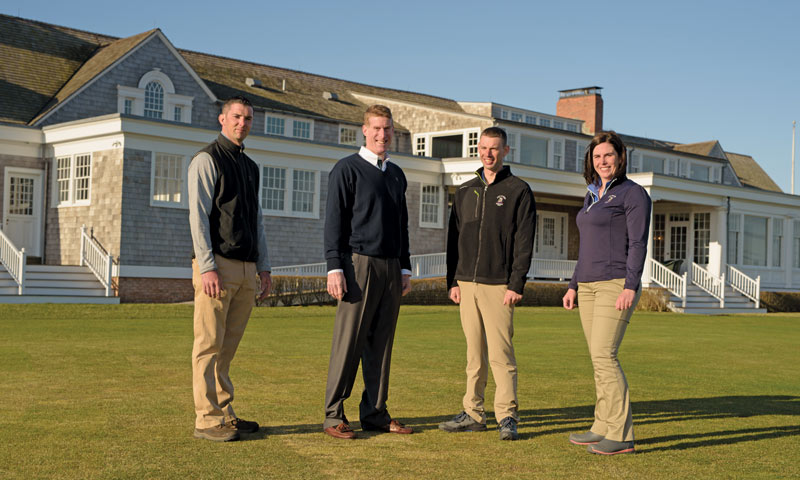
Superintendent Jon Jennings, CGCS, at Shinnecock Hills Golf Club, the only venue to host the U.S. Open in three different centuries. Photo by Benny Migliorino
The father’s daughter routinely awakened before dawn. A faint, rustling noise in the family kitchen on Aberdeen Lane meant one thing — it was time for Samantha Jennings to beat the sunrise and navigate the staircase with a purpose. “I would hear that cabinet open and close at the exact same time. Then I would hurry downstairs and give him a hug before he went to work,” she says.
The target of her affection, her father, Jon Jennings, CGCS, may have already gone on a run, shrouded in darkness, in his Southampton, N.Y., neighborhood on Long Island. You have to wonder, though, whether running after work might better suit this former Boston Marathon contestant.
“I’m wound tight. Like a snow globe you just shook,” Jennings says.
After his run, the daily bowl of oatmeal (usually covered with crushed pineapple), and a scan of The Wall Street Journal, Jennings is off and running to his place of employment. This month, the world will see what serves as his office. The 118th U.S. Open, scheduled for June 14-17 at Shinnecock Hills Golf Club, will be overseen by a superintendent whose pedigree aligns with his journey.
Jennings’ middle initial is S. That stands for Standish — as in Myles Standish, an Englishman who escorted the Pilgrims to America on the Mayflower in 1620 to establish a colony on the New England coast. Jennings’ father’s mother was a Standish.
Jennings, who is 54 and a 34-year member of GCSAA, has lived up to the Standish name by embracing challenges and guiding a team. Jennings was hired at Chicago Golf Club in Wheaton, Ill., in March 2000 to restore the esteemed facility, which was founded in 1892 and claims to be the oldest 18-hole course in the U.S. He was enlisted to do the same in March 2012 at Shinnecock Hills, which began play in 1891 (as a 12-hole course) and features what it says is the oldest clubhouse in America.
The hiring of Jennings at Shinnecock Hills was historic in its own right. He is believed to be the only golf course superintendent who has overseen more than one of the five charter clubs of the USGA. Besides Chicago GC and Shinnecock Hills, the other founding clubs are St. Andrew’s Golf Club in Yonkers, N.Y.; The Country Club in Brookline, Mass.; and Newport (R.I.) Golf Club.
“It wasn’t part of the plan. It wasn’t my career target,” Jennings says. “But it is pretty amazing to have your name associated with two clubs of such renowned stature. It came with progress, resources, and the desire to be the best you could be.”
It is no coincidence that Jennings is the person to accomplish the feat, according to Paul Vermeulen. “He is an overachiever in every way imaginable. He has more physical energy than any human being I have known. He’s always prepared for opportunity when opportunity knocks,” says Vermeulen, director of championship agronomy for the PGA Tour, who was a college student intern with Jennings at Olympia Fields (Ill.) Country Club. “I think you can see that in his career path.”
Jennings’ stamina serves him well. Where does it come from? Ask his father, Tom. “Persistence is one of his major accomplishments. He gets that from my wife (Fran). When she tackles something, she stays with it until it gets done,” he says.
Learning curve
Neither the road to Chicago Golf Club nor Shinnecock Hills was exactly a straight shot for Jennings.
GCSAA Class A superintendent Mike Chrzanowski hired him at Madison (Conn.) Country Club as a 12th-grader. Jennings soon learned he needed to be schooled for the job. “My first day, he had me walk-mow greens with a Toro 500. To this day, I don’t think I have ever seen lines on a green that looked so crooked,” Jennings says.
It was a matter of time — as in being punctual for work — before Jennings straightened out. “He was one of those high school kids on his last warning,” says Chrzanowski, a 38-year association member. Jennings and a friend who worked with him at Madison CC devised a way to be on time. A key element in their plan was Jennings’ mother’s 1973 Ford LTD, a blue station wagon with wood panel siding. “We would go out at night and roll into the shop at 3 a.m. to sleep in our car. When we heard the first sound in the morning, we’d get out and go to work,” Jennings says.
Whatever works, right? Jennings began to earn Chrzanowski’s trust. “It was ambitious that he would sleep in the parking lot,” says Chrzanowski, who, more than a decade later, was in Jennings’ wedding.
The real turning point in Jennings’ career occurred at a member-guest event in which the grounds staff was invited to the dinner. Jennings reveled in what he heard. “Members spoke outwardly about the great work Mike had done preparing the golf course for play. It was shortly after that when I approached Mike and asked him how he got the job,” says Jennings, who followed in Chrzanowski’s footsteps by attending the University of Massachusetts.

Jennings (second from left) with his assistants (from left) Michael Ford, Bobby Bolin and Lindsay Brownson. Photo by Benny Migliorino
Jennings flourished in college. He earned an associate’s degree in golf course management and a bachelor’s degree in resource economics. He was invited to apply to Harvard Business School, among others, upon graduation. For him, though, there was no business like the golf business. Joseph Troll, Ph.D., of UMass, inspired Jennings.
“He spoke sternly to us the first day of class. He said, ‘In five years, half of you won’t be in the golf business.’ That scared me to death. I was determined not to be part of that statistic,” Jennings says. “Once I had a clear direction and decided what I wanted to achieve, I became extremely focused on the path, getting there through effectiveness and doing what others wouldn’t.”
Roads well-traveled
The journey to Shinnecock Hills for Jennings — personally and professionally — began in earnest 30 years ago. He landed his first superintendent job in March 1988 at En-Joie Golf Club in Endicott, N.Y. Besides hosting the PGA Tour’s B.C. Open, En-Joie did a complete bunker renovation on Jennings’ watch. He left 13 months later to become superintendent at Hiland Golf Club in Queensbury, N.Y. That’s when he met Susan Roberts. They crossed paths on a Friday evening at a Sunoco station. She’d pulled in to inflate a tire on her Saab before a road trip. Jennings, meanwhile, pulled up in a Saab of his own. If this was a pickup line, well, it worked.
“He said, ‘My Saab is a lot cleaner than your Saab,’” Susan says. Less than two years later, they got married, just before he was hired as superintendent at The Patterson Club in Fairfield, Conn., where Jennings oversaw the completion of a long-range maintenance plan that featured a complete bunker renovation and extensive drainage installation. He left there 18 years ago for Chicago GC, which was pondering an agronomic upgrade at the time. It was a major step for the club — and for Jennings.
Pat Sisk, CGCS, went to middle school with Jennings and knows him as well as anybody. He knew what Chicago GC had acquired. “Even at 12, he was pretty driven. Don’t tell him he can’t do something. He’ll figure out a way to do it,” says Sisk, a 26-year GCSAA member at Milwaukee Country Club. “I’m very proud of my buddy. I’ll probably never host a major. I’m living this one vicariously through him.”
Chicago GC was at a crossroads when Jennings came aboard. “In the previous 50 to 60 years before Jon, I don’t think the membership wanted big events,” says John Moran, a Chicago GC historian and former green chairman there. “We asked ourselves, ‘Are we going to come into the 21st century in terms of agronomic practices?’ We pretty much had never aerated, injected sand in the greens or topdressed. Jon taught me a lot. He helped me help the members better understand.”

Jennings (center) with equipment manager Kevin Stoeckert (left) and crew member Angel Vallespil. Photo by Benny Migliorino
Jennings guided an agronomic revival there, which featured work done by architect Tom Doak. Bunkers were restored, as were playing areas that had migrated over time. The challenge of implementing bentgrass in the fairways was overcome. All of it was done in time to host the 2005 Walker Cup.
“He brings out the best in each employee, makes everybody feel they’re part of the team, part of the family,” says Aaron Willing, an assistant for Jennings at Chicago GC. “He’d put out a challenge, I’d accept the challenge, I’d conquer the challenge, then go one step further.”
Obviously, Chicago GC still showcases what Jennings launched, which continues under current GCSAA Class A superintendent Scott Bordner, a 16-year association member. Next month, the club will host the U.S. Senior Women’s Amateur, which is coming to Chicago GC for the first time. Although Jennings is gone, he’s not forgotten. “He took us from being an outdated, tired golf course to being world-class,” says Steve Daly, the green chairman when Jennings was hired.
What Jennings has achieved doesn’t surprise Mark Russell, PGA Tour vice president of rules and competition. “Something that sets him apart is that when these nice clubs came looking for a superintendent, they looked for Jon,” Russell says.
Iconic renderings
Shinnecock Hills and Chicago GC offer quite the canvas. Jennings drew on his skills to aid in the restoration of their roots.
“Both are like museums. It’s no different than having a masterpiece of art. All we did was freshen up the frame,” he says. “If you look at the foundation of both golf courses, they were intact. We just cleaned them up and made them look shinier.”
The main commonality to the restorations that were done at both clubs was the return of playing areas to their original locations. What will patrons or viewers notice most about the changes at Shinnecock Hills? Fairways that are wider than before, including all 14 of the par 4s and par 5s.
The entire agronomic plan was guided by the USGA in a collaborative effort with Shinnecock Hills. Fairways will be as much as 15 yards wider compared with when the last U.S. Open was hosted there in 2004. They will average 41 yards wide rather than 26 yards, according to Darin Bevard, director of championship agronomy for the USGA Green Section. The project, which included replacing 7 acres of fairways and greenside surrounds with intermediate-mowed fescue and seedhead fescue, was completed in September in 10 days.
“Restoring some of the angles was important for challenging these guys with the ultimate test of golf,” Bevard says.
Shinnecock Hills is more than 400 yards longer now than it was 14 years ago. The par 70 will play at more than 7,400 yards. Grasslands were restored to their original perimeters. Ten new tees were added, including No. 18. Stone contamination was eradicated from all greenside bunkers, and trees were removed. Jennings says dunes that fit brilliantly into the course architecture make for breathtaking views. Hydration factors were adjusted, including the positioning of sprinklers so they don’t throw into native areas. The dunes also have a sandier appearance — the way they looked in the 1930s — a decision that was made after revisiting images of Shinnecock Hills from that era. The bentgrass/Poa annua greens were overseeded to incorporate more bentgrass.

Shinnecock Hills has played host to four previous U.S. Opens (1896, 1986, 1995 and 2004). Shown here is Shinnecock’s 14th hole. Photo by the USGA/John Mummert
A steady breeze seems to blow at Shinnecock Hills, a byproduct of its proximity to the Atlantic Ocean. Although summertime brings a prevailing southern wind, Jennings advises anyone who comes to the U.S. Open to bring a coat. “You’ve got to dress like it’s 10 degrees cooler,” he says.
The heat is on, though, when you are prepping for an event of this magnitude. Fact: Shinnecock Hills is the only club to host the U.S. Open in three different centuries, including the second championship.
No sweat, says Michael Ford, one of Jennings’ assistants at Shinnecock Hills who interned for him at Chicago GC. “Both places, Chicago and here, are historical, membership-driven, successful. They know what they want,” Ford says. “It can be a stressful position to be in, but it can be successful, and it will be with Jon. He’s an intense individual — not just at work, but anything he does. He takes everything to the next level.”
Jennings, whose game was once good enough to make him a 9 handicap, had practice for what has played out at Chicago GC and Shinnecock. Although he spent only 13 months as the assistant at Onondaga Golf & Country Club in Fayetteville, N.Y., it was there that Jennings, working alongside UMass classmate Erick Holm, had his first significant encounter with helping to restore a golf course to its original appearance.
“We brought the course up to speed with a modern approach to turfgrass maintenance,” says Holm, noting that regular verticutting became routine. “Jon got his feet wet on those kinds of things at a club with a big reputation in the area — big expectations in the finished product in that community. The pressure was on from when he started. Jon and I had a lot in common. It was a no-holds-barred, can-do attitude. He has the intellect, the drive.”
Asked how he feels about Jennings hosting a U.S. Open, Holm is certain of the outcome. “Piece of cake. He set himself up perfectly to build for this accomplishment,” Holm says.
Fergie, James Bond, and a first
When he isn’t on the scene at Shinnecock Hills, Jennings is probably doing the music scene. Or, he could be tidying up the home — maybe even yours.
He’s seen the Grateful Dead 25 times. Samantha, who works in nonprofit administration, often accompanies him to concerts. They’ve seen Steely Dan, Fergie, The B-52s — you name it. She’s thrilled that he takes time to chill. “He’s one of the most tenacious people I’ve encountered in my life,” says Samantha, whose aunt, Jon’s sister Martha, will work on his volunteer crew. “If something needs to be done and he finds out about it, he gets it done.”
Jennings came home one time and Susan, smiling, asked whether he noticed anything different on the patio deck. Long story short: She’d planted geraniums. “I said, ‘The geraniums need some water.’ I don’t see the good. I see the things that need to be done. I’m the guy who walks into your house, and when you turn your back, I’ll straighten out the picture on your wall. But I’ll be polite and wait until you turn your back,” Jennings says.
His son, Ted, who attends the University of Minnesota, is important to the family backbone. “Ted’s the guy who holds the door for 50 people before he goes in himself. He’s on a bone marrow donor list at Minnesota. He always gives blood. He puts me to shame,” Jennings says.

The third hole at Shinnecock Hills Golf Club is a par 4 that features a long approach shot to the green. Photo by the USGA/John Mummert
To keep his mind occupied, Jennings receives the Merriam-Webster Word of the Day via email, and makes it his goal is to integrate it into his vocabulary. He loves watching James Bond movies. Of course, there’s a reason behind that. “I find that despite any setback that comes his way, he manages to accomplish the given assignment with resourcefulness,” Jennings says.
Sounds like someone we know. Someone who ushered in new eras at old, legendary golf courses and is now about to host his first U.S. Open. Someone who dared. Someone who hopes to deliver. Again.
“It could be the greatest thing I achieve in my career,” Jennings says.
Howard Richman is GCM’s associate editor.